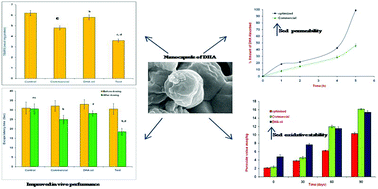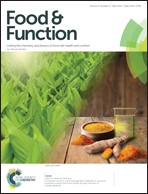Nanoencapsulation of docosahexaenoic acid (DHA) using a combination of food grade polymeric wall materials and its application for improvement in bioavailability and oxidative stability
Abstract
Docosahexaenoic acid (DHA) is a vital structural component of neuronal tissue, which is critically required during pre- and post-natal brain development. Its liquid nature, fishy odor, poor bioavailability and oxidative stability are the major challenges in the development of a pharmaceutically elegant and stable formulation. In the present study, nanocapsules of DHA from microalgae oil were prepared using different combinations of wall materials (carbohydrates, polymers, gum and proteins). The encapsulation using spray drying was done to prepare a pharmaceutically stable DHA formulation. The optimized formulation had a nanometric particle size (780 nm), spherical shape, an encapsulation efficacy of 98.46 ± 1.1% and good oxidative stability, both under refrigerated and accelerated storage conditions. Brunauer–Emmett–Teller (BET) analysis of the powder depicted a higher surface area and pore diameter and a lower particle size range. An ex vivo intestinal permeability study demonstrated a two fold increase in absorption in comparison with a commercial DHA formulation. Furthermore, an in vivo biodistribution study demonstrated a 2.9 fold increase in brain DHA concentration in comparison with pure DHA oil. In vivo testing for memory enhancement effects using Normal Object Recognition (NOR) and Morris water maze models with histopathological studies demonstrated memory enhancement with an increase in the proliferation of neurons in the hippocampus area. Thus, this study indicated that combinations of wall materials were better for the effective encapsulation of DHA oil for improving its bioavailability, shelf life and oxidative stability.



 Please wait while we load your content...
Please wait while we load your content...